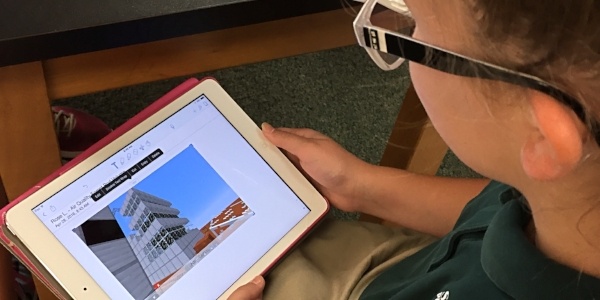Balancing the benefits of technology against its distractions, especially for middle school students, is an important topic for educators and parents alike. Recently I shared some tips on starting a conversation with your student about her use of technology. Remember, our Middle School students have a facility with the device that adults usually do not. However, there is a need for parents to monitor the way a student uses his or her device.

This year, the Middle School instituted a more restrictive cell phone policy for the students while at school. The change was made with a bigger picture in mind: finding the balance between using tech tools and developing interpersonal skills. Middle School students are not allowed to have their cell phones out while at school, until after sports practices and drama rehearsals are over. We have declared the Middle School breezeway a tech free zone all day. Lunches and break times continue to be tech free.
The teachers and I recommend that parents consider continuing certain restrictions beyond school hours:
1. Turn off the phoneWe’ve all experienced it. The faint tingle that we imagine coming from a pocket or purse. A phantom cell phone ring. The phenomenon is so common that adults even experience the phantom ring when they are not carrying their phone: and, of course, adults are usually less tied to their phones than teenagers. Here are a few ideas to give your student a much-needed break from their phone:
- Have cell phone charging take place outside the bedroom to ensure that the phones are away during sleep hours at night.
- Carve out strict no tech times for the family (adults included). This should cover meal times at a minimum, and other time during the weekday and weekends.
- Engage in conversations with students about cell phone and tech use.
- Apps like Moment help monitor time spent on a device, which gives you good data to discuss with your teen.

2. Be Aware of Inappropriate Apps: Some apps give the illusion of privacy when texting or messaging on a mobile device. Snapchat is a popular app that auto-deletes messages, creating the idea that what one says won’t be seen again. Although middle school students will want to have this app on their phone, it is not a good app for children that age.
If your student has this app, he has access to an app that has a reputation as the “sexting app”, is well known as a drug dealer app, and is a way for strangers to discreetly connect with your student. In other words, it is an app that poses significant risk to developing brains.
If you ever want to know what has been on your student’s cell phone or iPad, there is an easy way to check. Just open the app store and go to “updates.” Then click on “purchased” and you will see all of the apps that have ever been downloaded onto that device. Best of all, they are listed in order from most recent to oldest.
Jonathan Davis is the Head of Middle School at Shorecrest. Visit the Shorecrest campus to learn more about the 5th-8th grade Middle School program.

















